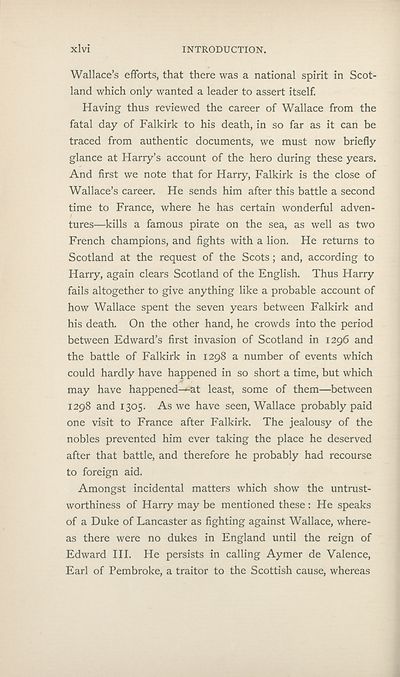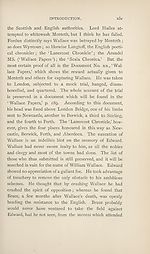Scottish Text Society publications > Old series > Actis and deidis of the illustere and vailzeand campioun, Schir William Wallace, Knicht of Ellerslie
(50) Page xlvi
Download files
Complete book:
Individual page:
Thumbnail gallery: Grid view | List view

xlvi
INTRODUCTION.
Wallace’s efforts, that there was a national spirit in Scot¬
land which only wanted a leader to assert itself.
Having thus reviewed the career of Wallace from the
fatal day of Falkirk to his death, in so far as it can be
traced from authentic documents, we must now briefly
glance at Harry’s account of the hero during these years.
And first we note that for Harry, Falkirk is the close of
Wallace’s career. He sends him after this battle a second
time to France, where he has certain wonderful adven-
tures—kills a famous pirate on the sea, as well as two
French champions, and fights with a lion. He returns to
Scotland at the request of the Scots; and, according to
Harry, again clears Scotland of the English. Thus Harry
fails altogether to give anything like a probable account of
how Wallace spent the seven years between Falkirk and
his death. On the other hand, he crowds into the period
between Edward’s first invasion of Scotland in 1296 and
the battle of Falkirk in 1298 a number of events which
could hardly have happened in so short a time, but which
may have happened—^-at least, some of them—between
1298 and 1305. As we have seen, Wallace probably paid
one visit to France after Falkirk. The jealousy of the
nobles prevented him ever taking the place he deserved
after that battle, and therefore he probably had recourse
to foreign aid.
Amongst incidental matters which show the untrust¬
worthiness of Harry may be mentioned these : He speaks
of a Duke of Lancaster as fighting against Wallace, where¬
as there were no dukes in England until the reign of
Edward III. He persists in calling Aymer de Valence,
Earl of Pembroke, a traitor to the Scottish cause, whereas
INTRODUCTION.
Wallace’s efforts, that there was a national spirit in Scot¬
land which only wanted a leader to assert itself.
Having thus reviewed the career of Wallace from the
fatal day of Falkirk to his death, in so far as it can be
traced from authentic documents, we must now briefly
glance at Harry’s account of the hero during these years.
And first we note that for Harry, Falkirk is the close of
Wallace’s career. He sends him after this battle a second
time to France, where he has certain wonderful adven-
tures—kills a famous pirate on the sea, as well as two
French champions, and fights with a lion. He returns to
Scotland at the request of the Scots; and, according to
Harry, again clears Scotland of the English. Thus Harry
fails altogether to give anything like a probable account of
how Wallace spent the seven years between Falkirk and
his death. On the other hand, he crowds into the period
between Edward’s first invasion of Scotland in 1296 and
the battle of Falkirk in 1298 a number of events which
could hardly have happened in so short a time, but which
may have happened—^-at least, some of them—between
1298 and 1305. As we have seen, Wallace probably paid
one visit to France after Falkirk. The jealousy of the
nobles prevented him ever taking the place he deserved
after that battle, and therefore he probably had recourse
to foreign aid.
Amongst incidental matters which show the untrust¬
worthiness of Harry may be mentioned these : He speaks
of a Duke of Lancaster as fighting against Wallace, where¬
as there were no dukes in England until the reign of
Edward III. He persists in calling Aymer de Valence,
Earl of Pembroke, a traitor to the Scottish cause, whereas
Set display mode to: Large image | Zoom image | Transcription
Images and transcriptions on this page, including medium image downloads, may be used under the Creative Commons Attribution 4.0 International Licence unless otherwise stated. ![]()
| Permanent URL | https://digital.nls.uk/107001139 |
|---|
| Description | A collection of over 100 Scottish texts dating from around 1400 to 1700. Most titles are in Scots, and include editions of poetry, drama, and prose by major Scottish writers such as John Barbour, William Dunbar, Gavin Douglas, and George Buchanan. Edited by a key scholarly publisher of Scotland's literary history, and published from the late 19th century onwards by the Scottish Text Society. Available here are STS series 1-3. |
|---|

